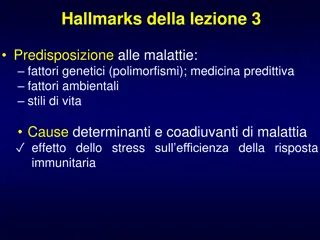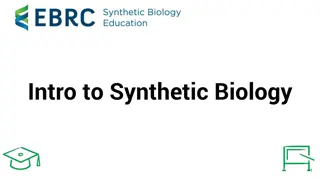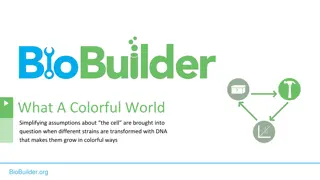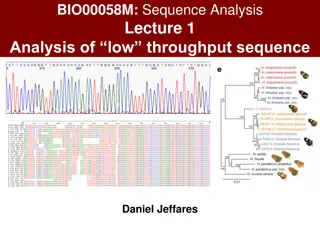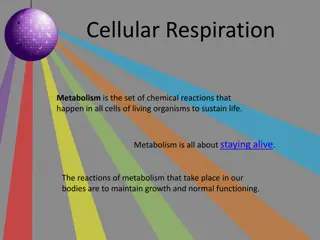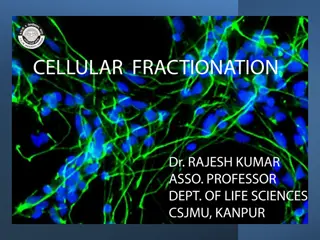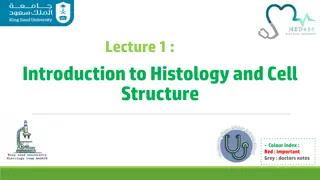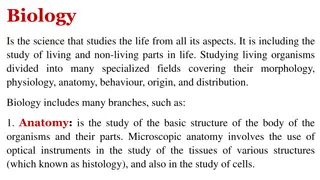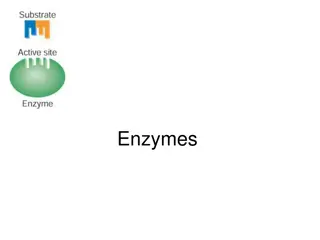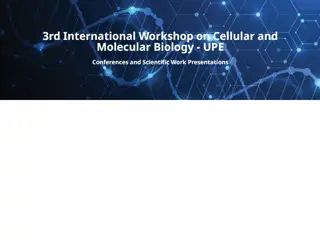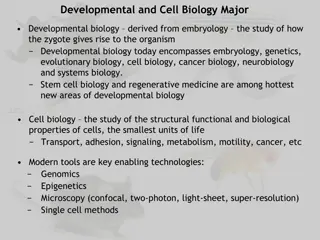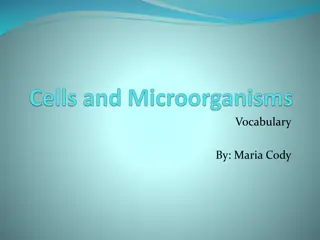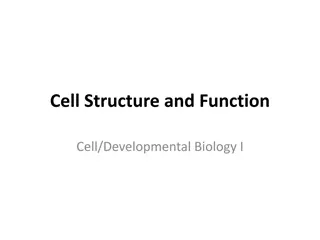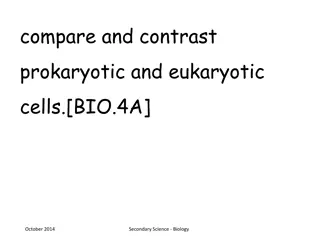Cellular Structures in Quizbowl Biology
Biology in quizbowl competitions often focuses on understanding cellular structures, from organs to organelles. Players encounter questions about various organelles like mitochondria, ribosomes, chloroplasts, and the Golgi body. Ribosomes, though not classified as organelles, play a critical role in protein synthesis. Mitochondria are known for energy production and are linked to various diseases. Chloroplasts are essential for photosynthesis. The Golgi body has distinct faces and functions in protein processing and transport. This dynamic field challenges participants to apply their knowledge of cellular biology in a quiz setting.
Download Presentation

Please find below an Image/Link to download the presentation.
The content on the website is provided AS IS for your information and personal use only. It may not be sold, licensed, or shared on other websites without obtaining consent from the author.If you encounter any issues during the download, it is possible that the publisher has removed the file from their server.
You are allowed to download the files provided on this website for personal or commercial use, subject to the condition that they are used lawfully. All files are the property of their respective owners.
The content on the website is provided AS IS for your information and personal use only. It may not be sold, licensed, or shared on other websites without obtaining consent from the author.
E N D
Presentation Transcript
Quizbowl Biology FROM ORGANS TO ORGANELLES
Why Biology? Biology is the one area of the quizbowl science canon that seems to come more intuitively than others, such as physics Introductory concepts are typically mandatory for students to take in high school
Organelles Come up frequently in canon Typically introduced as this structure , etc. Most common answerlines are mitochondria, lysosomes, Golgi body, etc. Some packets will toss up ones you aren t used to hearing on easier packets (e.g. cilia, vacuoles)
Ribosomes Not classified as organelles, but fall in the same realm of cellular structures Size is measured in Svedberg units- denotes sedimentation rate in centrifuges Have A (aminoacyl), P(peptidyl), and E (exit) sites Shine-Dalgarno sequence- ribosome binding site on prokaryote mRNA Kozak sequence- corresponding site for eukaryotes EF-Tu- elongation factor that enters the ribosome Produced in nucleolus Found inside mitochondria and chloroplasts
Mitochondria Contain TIM/TOM complexes- transport proteins in and out Inner membrane contains folds called cristae Contains ATP synthase- has F1 and F0 subunits Give brown fat its color Performs thermogenesis- contain thermogenin (UCP1) Diseases: MERRF syndrome ragged red fibers produced under Gomori stain Leber s hereditary optic neuropathy Salt and pepper retina Kearns-Sayre Syndrome Leigh s Disease Associated molecules: coenzyme A, acetyl CoA, cytochrome c (released during apoptosis), ubiquinone, coenzyme Q, cardiolipin (associated with Barth syndrome)
Chloroplasts Contain TIC/TOC complexes and antenna complexes VIPP1- membrane protein Contain structures called stromules RuBisCO- enzyme involved in CO2 fixation
Golgi Body Has cis and trans faces Cis face tags proteins destined for lysosomes with mannose-6-phosphate Contains GAAP- protein that prevents apoptosis COPI - coats vesicles going from Golgi (cis face) to ER COPII - coats vesicles going from ER to Golgi
ER (Endoplasmic Reticulum) Has rough and smooth varieties: rough is studded with ribosomes, smooth is not Continuous with nuclear membrane Contains the KDEL retention sequence Sarcoplasmic reticulum form releases calcium ions in smooth and striated muscle cells, responsible for detox and steroid production COPI and COPII clues apply to this as well- learn which one leaves which organelle
Nucleus Its lamina acts as a support structure RAN protein mediates transport in and out of it thru pores in its membrane (porins) Can be viewed with DAPI and Hoechst stainings Contains Cajal bodies and snRNPs Contains SUN domain proteins Continuous with ER Any word with the prefix karyo- refers to it
Lysosomes Responsible for digesting old cell parts, food, etc. - autophagy Diseases resulting from their malfunction: Gaucher s, Niemann-Pick, I(nclusion)-cell, Pompe, Hurler Syndrome, Fabry s disease, Tay-Sachs Tay-Sachs is caused by the malfunctioning of the enzyme hexosaminidase A, similar to Sandhoff disease Vesicles destined to it are tagged with mannose-6-phosphate V-class proton pumps (aka V-ATPase) Discovered by Christian Rene de Duve Contain namesake hydrolases
Peroxisomes Break down peroxides Contain catalase- breaks hydrogen peroxide down into water and oxygen Affected in Zellweger syndrome, X-linked adrenoleukodystrophy, Refsum s disease aka Infantile Refsum disease (IRD)
Plasma Membrane Contains flippases, scramblases, integrins, cadherins Old model- Davson-Danielli Fluid mosaic model- developed by Singer and Nicolson Cholesterol regulates its mobility Contains clathrin coated pits and lipid rafts Integral and peripheral proteins Blebbing- bulging during apoptosis Names for it in different cells end in lemma (sarcolemma, oolemma, axolemma) Contain glycolipids (including gangliosides, which come up in lysosome tossups, so listen to the question) G-protein coupled receptors
Diseases and Pathogens Extremely large depth to draw from, but major genetic diseases and viruses/bacterial strains come up often
Viruses- HIV and Influenza HIV envelope proteins gp120 and gp41 CD4, CCR5, and CXCR4 receptors Influenza genus Orthomyxoviridae M2 ion channel/proton pump Bind to sialic acid sugars on plasma membrane Contains glycoproteins neuraminidase and hemagglutinins Treated by oseltamivir and zanamivir
Malaria Duffy antigen negative individuals are resistant to it Treated by artemisin and quinine (extracted from cinchona bark) Species: vivax, falciparum, knowlesi Genus Anopheles Thalassaemias and glucose-6-phosphate dehydrogenase deficiency confer resistance to it
Cholera John Snow- investigated 1854 outbreak in Soho, London, traced it to a pump on Broad Street Causes G-proteins to perform constitutive cAMP production Genus Vibrio Symptoms treated with oral rehydration therapy Asiatic form Treated by tetracycline Careful buzzing on antibiotic clues
Tuberculosis (TB) Ziehl-Neelsen stain detects it causes caseating granulomas Pott disease- it affects the spine PPD test causes Ghon foci one drug that treats it inhibits arabinosyltransferase (Ethambutol)
Syphilis Treponema pallidum Treated by Salvarsan/arsphenamine Causes a chancre to form VDRL and FTA tests In the nervous system- can cause Argyll Robertson pupils (aka: prostitute s pupils) and tabes dorsalis Can manifest as sabre shins or snuffles in infants
Cystic Fibrosis Diagnosed by a sweat test- involves application of pilocarpine Screen for it in infants measures levels of immunoreactive trypsinogen delta-508 deletion deletion of single penylalanine on chromosome 7 G551D mutation causes one form- treated by Ivacaftor congenital absence of the vas deferens Results in clubbing in fingertips and extremities Heterozygotes for it can have resistance against cholera, typhoid, and tuberculosis Children with it often have chronic vitamin K malabsorption Protein mutated is anchored to cytoskelton via C-terminal PDZ-interacting domain Sufferers unable to transport thiocyanate and produce hypothiocyanate
Cystic Fibrosis (cont.) splice donor in MSD1 domain of affected protein is abolished mutations in neutrophil-associated gene IFRD1 can be treated with N-acetylcysteine or the DNase Dornase Alfa Sufferers are susceptible to chronic Burkholderia cepacia and Pseudomonas aeruginosa infections Acrophialophora fusispora infections are almost exclusively found in sufferers of it Shwachman-Diamond syndrome is often misdiagnosed as it sufferers often take lipase to aid digestion- impaired by scarring of pancreas
Sickle Cell Anemia Results in vaso-occlusive crises and autosplenectomies Glutamic acid substituted for valine at position 6 Treated by hydroxyurea and prophylactic penicillin Infant dactylitis Heterozygotes for it have resistance to malaria
Alzheimers hyperphosphorylation of tau proteins- microtubule disintegration Associated with E4 allele of ApoE gene Treated by: memantine, galantamine, rivastigimine Overexcitement of glutamate receptors can cause nerve cell death SORL1 gene Donapezil treats it by increasing acetylcholine Low blood progranulin and elevated Dkk-3- signifiers Beta-secretase leads to long term effects S100B levels in serum can indicate progression presenilin-1 and 2 genes diagnosed with the MMSE Namenda treats it by acting as an N-methyl-D-aspartate receptore antagonist One protein associated with it selectively activates Death Receptor 6
Huntingtons Westphal variety- early onset, aka akinetic-rigid High frequency in Afrikaners- due to founder effect Mutation of chromosome 4 CAG repeats in polyQ region- longer polyglutamine track than normal Same mutation causes Kennedy's disease when on the androgen receptor gene of X chromosome Treated by tetrabenzanine Cause discovered by Wexler Classified by Vonsattel grading system Results in low levels of CREB Affected protein (huntingtin) Sumoylated by Rhes- results in its disaggregation mainly expressed in striatum of basal ganglia- loss of GABAergic neurons interacts with Hip1-clathrin binding protein
Organs Major organs (liver, stomach, etc.) come up often, but also parts of organs (alveoli, nephrons, etc.) Some organ tossups will catch you off guard if you aren t aware of their classification as organs (e.g. placenta)
Liver Accumulation of bilirubin from heme breakdown in it causes jaundice Crigler-Najjar syndrome (CNS)and Gilbert syndrome- affects bilirubin metabolism Produces: Cholesterol Albumin Primary producer of IGF-1 and angiotensinogen Its round ligament is on free edge of its falciform ligament The uterus also has a round ligament- be careful Blood flows into it through portal vein Blocked in Budd-Chiari syndrome Contains Kuppfer cells (macrophages) and Ito cells Surrounded by Glisson s capsule
Lungs Contains Clara/club cells Converts angiotensin I to angiotensin II Alveoli May contain corpora amylacea (also found in the prostate) Destroyed with glomerulus in Goodpasture's syndrome Affected by hyaline membrane disease Contain pores of Kohn Lined with surfactants
Spleen Banti's syndrome-results in its enlargement Contains red and white pulp and marginal zone Malphigian corpuscles (also found in nephrons in kidney) Cords of Billroth-connects its sinusoids Contains a reserve of monocytes Absent in Ivemark syndrome Produces the tetrapeptide tuftsin (threonine-lysine-proline-arginine)

 undefined
undefined






